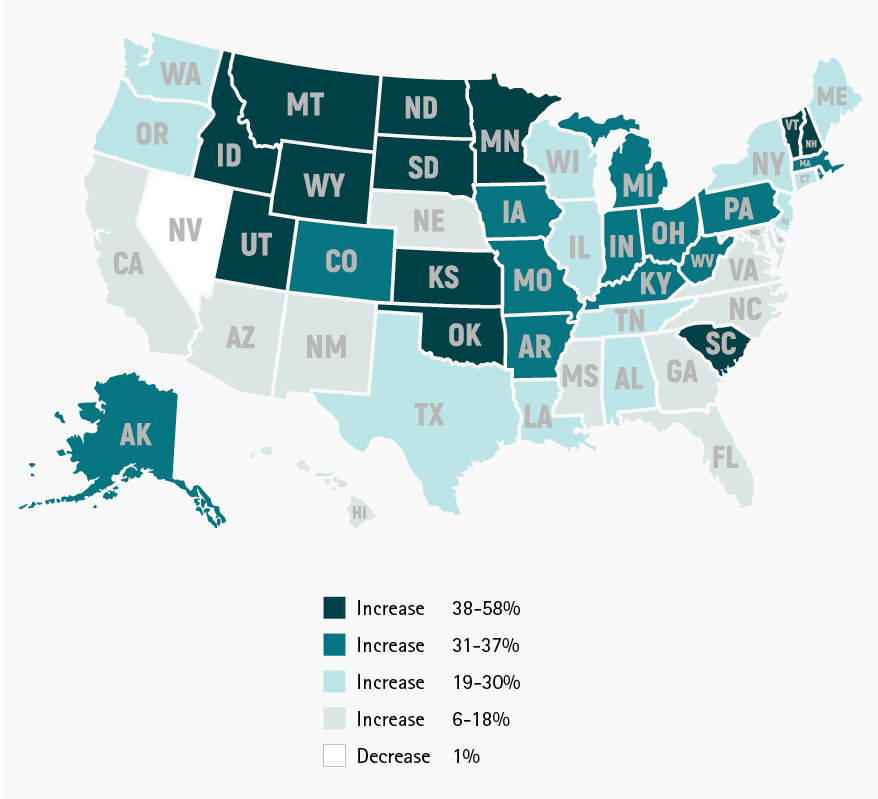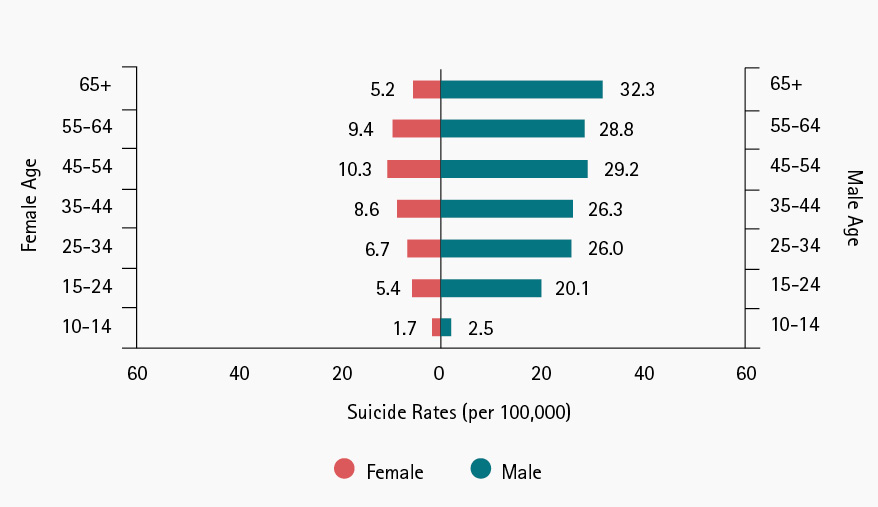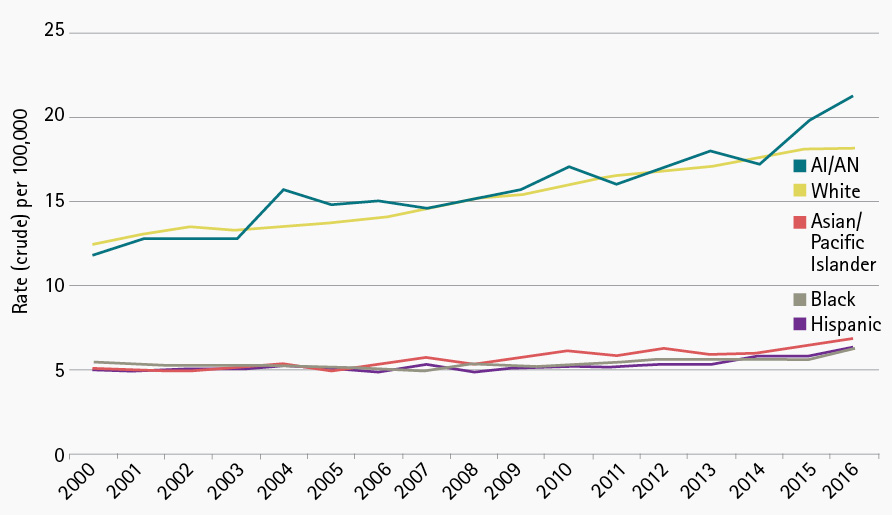
Firefighter suicide has been getting more attention in recent years. It is frequently associated with astronomically rising rates and a call to action to reduce this “epidemic.” Although the call to action is vital, it is worth considering whether the rate is actually rising to the extent put forth in the media. A realistic examination of what we do and do not know about firefighter suicide will challenge some commonly accepted beliefs about the suicide rate. Firefighter suicide is a serious issue, and the focus here is to ensure that we are discussing suicide accurately so that, if challenged, claims can be confidently defended. Eyebrow-raising statistics have a shock factor that demands attention; but if those statistics cannot withstand scrutiny, they lose their value, and the presenter loses credibility.
Determining Rates
Simply put, a rate is “a measure, quantity, or frequency, typically one measured against some other quantity or measure.”1 Mathematically, this may be represented by a fraction. Calculating the firefighter suicide rate involves measuring the number of firefighter suicides within a certain group against the total number of firefighters within that group. It can be represented mathematically as
Total number of firefighter suicides
in a given group
Total number of firefighters contained
in that same group
The result of that fraction is then normally adjusted to represent how many firefighters will die by suicide if the overall group contained 100,000 firefighters. This rate-per-100,000 conversion is standard to allow researchers to compare different sized groups with one another. To see this formula in action, assume that within a group of 10,000 firefighters, two die by suicide. The rate calculation would be as follows:
(2 ÷ 10,000) × 100,000 = .0002 × 100,000 = 20 suicides per 100,000 firefighters
The simplicity of the formula, however, belies several complex issues with getting accurate figures to calculate the equation. The first consideration is from what group will suicide figures be gathered to determine the denominator. Will we use volunteer firefighters? Career firefighters? Firefighters from combination departments? A mixture of all? Once you determine which group you will use as the denominator, you will have to figure out a method to ensure that your accounting of that group’s members is accurate. There is not enough space in this article to fully discuss all the complexities involved with statistical sampling, but suffice it to say that accurately and reliably determining the denominator of this equation can be remarkably cumbersome and complex.
Once you have determined which group you will use, you will have to determine the numerator: the total number of firefighter suicides in that group. Because there is no single source to which all firefighter suicides are reported, it is often impossible to accurately state how many suicides have occurred within a group. Adding to the difficulty of finding an accurate numerator is the widely accepted belief that suicide is underreported.2
The International Association of Fire Fighters (IAFF) is undertaking a promising effort to collect accurate data—a reporting system whereby local union leaders can report member suicides (both past and present). The IAFF maintains highly accurate membership data that will make determining the denominator much easier than other methods. However, as family members are not required to disclose the cause of death of a firefighter, ensuring that all member suicides are reported to the IAFF will remain a potential issue. But, because behavioral health is something the IAFF takes seriously, it is anticipated that local union leadership will comply with requests from the IAFF to report the data if they have it. Overall, this IAFF effort provides a potentially enlightening opportunity to gather better suicide rate data for career firefighters in the United States and Canada.
The purpose of this introductory section was to present the complexities of gathering reliable firefighter suicide data. For the sake of argument, let us assume that we have overcome the obstacles discussed above and have a reliable suicide rate. What now? What is the point of gathering the data and calculating a rate of suicide for firefighters? Generally, the basis for establishing a rate is to compare it to the rates of other groups, and this is where serious problems arise.
Comparing Rates
There is an inclination to compare firefighter suicide rates to the suicide rate of the general population. After all, if we want to see whether firefighters have a higher suicide risk than the general population, isn’t this the best way to do it? Well, no; it isn’t. The goal should be to determine if there is something inherent in firefighting that makes the suicide risk higher. You may be thinking, “Wait a minute. I can look at two numbers and compare them. If the firefighter suicide rate is higher than that of the general population, that tells us that firefighters are at a higher risk for suicide than the general population. Case closed.”
But, the question we have routinely neglected to ask is whether that rate is higher because they are firefighters. In fact, when looking at some pretty basic suicide data, it isn’t surprising that we see the numbers of suicides among firefighters that we see, and it very likely has nothing to do with being a firefighter.
First, an examination of the overall suicide rate in the United States is instructive. According to the Centers for Disease Control and Prevention (CDC), the suicide rate in the United States increased in 49 out of 50 states and went up 25.4 percent from 1999 to 2016 (Figure 1). If the rate is rising among the population generally, then one can expect it might be rising among firefighters specifically.
Sex and age are also relevant factors when discussing suicide rates. The National Institute of Mental Health (NIMH) reports that men are far more likely to die by suicide than women (Figure 2). Additionally, NIMH research indicates that men have increasing suicide rates as they age, particularly from middle age on. Also, according to the CDC study, the highest increase in the suicide rate from 1999 to 2016 occurred among those who were ages 45 to 64.
Figure 1. United States Suicide Rates: 1999-2016

Let’s examine a final demographic relevant to this discussion: race. When comparing the suicide rate among blacks, Hispanics, Asian/Pacific islanders, American Indians/Alaska natives, and whites, the data reveal that whites are at a significantly higher risk of suicide than most other racial groups (Figure 3).
How can we bring all this together and make it relevant to a discussion about firefighter suicide? According to the Bureau of Labor Statistics, 94.9 percent of professional firefighters are male, and 87.1 percent of professional firefighters are white.3 Additionally, the average age of a United States firefighter is 38.8 years old.4 What the data discussed above tell us is that middle-aged white males are among the highest risk groups to die by suicide, and this is precisely the group that makes up the majority of the career fire service.5 With that information in mind, is it really surprising that we see more suicide among firefighters? The rate of suicide among firefighters quite arguably has less to do with being a firefighter than it does with being overwhelmingly comprised of a demographic with a higher risk of suicide overall.
Although the preceding discussion demonstrates the dangers of directly comparing firefighter suicide rates to those of the general population, to truly determine whether being a firefighter increases suicide risk, we must adjust our statistical data to account for those demographic differences. Fortunately, a few studies performed in public safety took these issues into account.
Figure 2. Suicide Rates for Females and Males: 1999-2016

Chicago (IL) Fire Department Suicide Study6
The Chicago Fire Department (CFD) suffered the suicides of seven active and retired firefighters over an 18-month period. Battalion Chief Dan DeGryse, who at the time was IAFF Local 2’s Employee Assistance Program coordinator, went searching for answers. He evaluated information about deceased active and retired Chicago firefighters from 1990 through 2010; he found that the CFD had a suicide rate of 24.98/100,000 from 1990 through 2010. The overall suicide rate for the United States was approximately 12/100,000 during that same period.
Thus, comparing the CFD rate with the overall U.S. rate, we would conclude that the suicide rate for the CFD is more than twice as high as that for the general population. DeGryse, however, recognized that to get the most accurate picture of the CFD suicide rate, it needed to be evaluated next to a more comparable group. After adjusting for demographic differences, the suicide rate of the civilian population to which the CFD was compared was 21.2/100,000. The CFD rate was still slightly higher than the comparison group rate, but it was a far cry from being twice as high. It should also be noted that the demographic adjustment to the civilian suicide statistic was for racial differences but not for age differences; adjusting for age would have pushed the comparable civilian rate even higher, perhaps surpassing the CFD rate.7 Either way, it should be clear that making demographic adjustments is vital for calculating the most accurate comparisons.
Philadelphia (PA) Fire Department Suicide Study8
Another extensive survey was conducted in Philadelphia. The study determined that the suicide rate among Philadelphia firefighters was 15.11/100,000. Of particular relevance was that all of the firefighters who died by suicide were males and the average age of the decedents was 42.85 years. This once again shows the importance of considering demographic characteristics of the sample group when comparing it to other groups. Although the study noted that the data collected was from a single, urban department and may not represent all agencies in all areas, it, nevertheless, calls into question our perceptions about higher-than-average firefighter suicide rates.
Law Enforcement Suicide Study9
The final study involves law enforcement data rather than firefighter data. Although the two groups are not perfectly comparable, there are many similarities between law enforcement officers (LEOs) and firefighters as far as what we are exposed to and our demographic makeups. For those reasons, an examination of the law enforcement study is instructive.
The study found that the suicide rate among law enforcement officers was 18.1 per 100,000. At the time of data collection for the survey, the rate of suicide among the general population was 12 per 100,000. But, because the LEO community is not comprised of the same demographic as the general population, researchers compared the LEO suicide rate to the suicide rate among white males ages 25 to 55. The rate of suicide for that demographic was 25.5/100,000, as compared to 18.1/100,000 for LEOs. There is no doubt that this demographic more accurately represents the demographic makeup of law enforcement in the United States, and it demonstrates that suicide rates among LEOs are lower than the suicide rate among the appropriate comparison groups.
Are the data that we have from these studies complete? Certainly not. As noted by the authors of the Philadelphia study, “[I]n order to advance the field, it is imperative that infrastructure is developed, tested, and implemented to accurately track firefighter suicides across multiple departments, spanning geographic location, nature of area served (e.g., rural, urban), and type (e.g., all-career, volunteer, hybrid, wildland).”10 Nonetheless, what has been revealed in recent studies indicates that our common beliefs about firefighter suicide rates are likely inaccurate.
If firefighter suicide rates have been misinterpreted, why do we hear so much more about suicide among firefighters now than in the past? Why does it appear to be happening more often? There are a few factors that play into it. First, as noted early in this article, the overall suicide rate in the United States has increased significantly over recent decades, with the highest increase is among middle-agers. It is entirely logical to conclude from the data that firefighter suicides are also increasing.
Another contributor to our overall awareness of firefighter suicide is social media. It wasn’t too long ago that when a firefighter died by suicide, you probably didn’t hear about it. All we had for news reporting was a printed newspaper and radio and television broadcasts, which likely would never cover a firefighter suicide beyond a fairly small radius. Now, however, we get e-mail alerts and social media updates about firefighter suicides across North America and abroad.
A final contributor might also be that we are finally bringing suicide out of the shadows. People are more willing to share that a family member or colleague died by suicide. As a result, we hear about them more often.
Figure 3. Suicide Rates Based on Race: 1999-2016

The goal of this article is not to downplay the severity of firefighter suicide. But, in the end, no one benefits from the promulgation of inaccurate information. Imagine making a pitch to administrators that your department needs to invest in behavioral health programming and as part of that, you use questionable suicide rate comparison data. You may open some eyes with startling numbers; but if you are taken to task for the basis of that information, you may lose a great opportunity to get behavioral health assistance to your people by losing credibility with the audience. The threat of firefighter suicide is real, and we can make the argument by referring to known suicides in our jurisdictions and elsewhere—the numbers and examples are certainly out there without focusing on rates at all. In the end, however, relying on faulty data to prove that point is inaccurate, misleading, and potentially counterproductive. So, let’s admit we don’t know as much as we wish we did, and let’s get to work on finding the best possible data to make the case that suicide prevention and behavioral health programming in our departments are necessary to save lives.
Endnotes
1. Google dictionary. Retrieved from https://www.google.com/search?rlz=1C1GGRV_enUS787US790&q=Dictionary#dobs=rate.
2. For a discussion of suicide underreporting see, e.g., Sainsbury, P & Jenkins, J. (1982). The Accuracy of Officially Reported Suicide Statistics for Purposes of Epidemiological Research. Journal of Epidemiology and Community Health (1979-), 36(1), 43-48. Retrieved from http://www.jstor.org/stable/25566296; Tøllefsen, I. M., Hem, E., & Ekeberg, Ø. (2012). The reliability of suicide statistics: a systematic review. BMC psychiatry, 12, 9. doi:10.1186/1471-244X-12-9; and Bournemouth University. (2015, April 7). Under-reported suicides: Hiding or compounding the tragedy. ScienceDaily. Retrieved March 6, 2019 from www.sciencedaily.com/releases/2015/04/150407123056.htm.
3. Bureau of Labor Statistics. (2018). Labor force statistics from the current population. United States Department of Labor. Retrieved from https://www.bls.gov/cps/cpsaat11.htm.
4. Data USA. Firefighters. Retrieved from https://datausa.io/profile/soc/332011/.
5. It probably also makes up the majority of the volunteer service, but that demographic data wasn’t readily available.
6. DeGryse, D. (November 30, 2015). Chicago Fire Department suicide study. Retrieved from https://www.rosecrance.org/chicago-fire-department-suicide-study/.
7. The suicide rate for white males between the ages of 25 and 55 for 1997 is 25.5. Hoyert, DL, Kochanek, KD, & Murphy, SL. (1999). National Vital Statistics Reports – Deaths: Final data for 1997. Hyattsville, MD: National Center for Health Statistics.
8. Daniels, RD, et al. (2013). Mortality and cancer incidence in a pooled cohort of US firefighters from San Francisco, Chicago and Philadelphia (1950–2009). Occupational and Environmental Medicine.
9. Stanley, IH, Hom, MA, Joiner, TE. A systematic review of suicidal thoughts and behaviors among police officers, firefighters, EMTs, and paramedics. Department of Psychology, Florida State University, 1107 West Call Street, Tallahassee, FL 32306, United States.
10. Stanley, IH, Hom, MA, Joiner, TE. Suicide mortality among firefighters: Results from a large, urban fire department. AM J Ind Med. 2016 Nov;59(11):942-947. doi: 10.1002/ajim.22587.
Brandon Dreiman is a captain and an 18-year veteran of the Indianapolis (IN) Fire Department, where he serves as the coordinator of Firefighter Wellness & Support. He travels the United States and Canada lecturing on behavioral health topics and, as an IAFF Peer Support Master Instructor, assisting fire departments with creating peer support programs. Dreiman is also an attorney. Prior to joining the fire service, he worked as a deputy prosecutor in southern Indiana.

